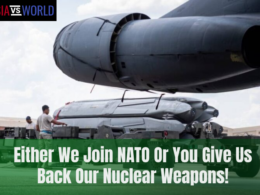Why our allies are lingering and what to demand from the West.
For the time being, Ukraine has been withstanding the onslaught of the Moscow horde, however, closing the skies over Ukraine remains one of the key issues for the security of our state. Are our Western allies ready to take such a step? And is this the only scenario to solve the problem? In three questions, we will look at why the West is dragging it out, what we may actually be losing, and what alternatives our diplomats should insist on.
What is this about?
As the term implies, it’s a specific military regime that “closes” the airspace in a certain area for aircraft of a state, military unit or individual organization. It completely isolates air and ground combat theaters for the other side, thus leveling its potential for air warfare. The «no-fly zone» concept has been devised quite recently, and applied by NATO countries during the 1990s and 2000s in Bosnia and Herzegovina, Iraq and Libya.
In all cases of its application, the no-fly zone proved its exceptional effectiveness. Being in fact 100% in possession of airspace, it allowed to carry out ground operations freely and to have a strategic initiative due to the superiority of its own aircraft. Accordingly, in all the cases described, this is exactly the course of operations we have seen.
Moreover, the no-fly zone is quite flexible in its instrumentality. It can be provided both by the absolute advantage of its own aviation and the invincibility of air defense systems; both with the help of allies and on their own (with their material support). But this flexibility might become an issue when it comes to the legal regime of such a zone. In the case of direct military confrontation, everything is quite simple – gaining full advantage in the air is one of the initial goals of any party to the conflict.
So, why not?
Despite the obvious advantages, even for their own security, the leaders of our Western partners are in no hurry to impose a no-fly zone over Ukraine. Neither the United States, nor the United Kingdom, nor any of the other powerful Western European allies dare to take such a step. However, the means and equipment on NATO’s eastern flank – especially given its recent reinforcement – have been more than enough for this purpose.
The main argument against interference for our partners is the risk of what they say is World War III. But here the counter question arises: isn’t it unfolding yet? Isn’t the broad involvement of third parties in the conflict and Moscow’s attempt to expand it to other neighboring states already creating sufficient threats? And finally, the deployment of nuclear capabilities; isn’t it the limit beyond which the West must act more decisively?
Apparently, the logic of Brussels, Washington, Berlin and Paris is that for now, sanctions alone can be a sufficient deterrent to the aggression. Indeed, the exchange rate of the Russian ruble and the massive food and commodity panic in major cities of Russia clearly demonstrate this. However, the barbaric tactics of shelling residential areas, which are currently being actively used by the Russian army, leave less and less moral basis for such a position of the West.
What are the alternatives?
One should not think that the lack of agreement of Western partners to activate a no-fly regime over Ukraine means a complete refusal of any aid in this direction. In the end, “it is not the strongest of the species that survives, … it is the one most adaptable to change” (oh, these old misreadings of biological classics!). That’s why Ukraine now needs to master the ability to create new values in international politics.
Right now, our diplomacy should focus on several key areas of work with partners:
Firstly, it is the creation of a restricted no-fly zone. This regime will close the skies over critical infrastructure, the destruction of which could cause environmental and man-made disasters on a continental scale. There are currently 15 nuclear power units in Ukraine, each of which could be a target for Russian aircraft or missile artillery. Even the very fact of the capture of Chernobyl and the threat of destruction of the radioactive waste shelter demonstrates the threat posed by the Russian armed forces to the security of the industry (and in fact to the security of much of the world). The closed skies over these facilities guarantee European security and prevent Russian blackmail.
Secondly, it is the strategic supply of air defense equipment and aircraft. Ukraine is currently well motivated to fight the aggressor by all available means. But, as it always happens in asymmetric conflicts, we lack technical support. Therefore, the provision of air defense systems and strengthening the air force fleet will help to increase security in the skies of Ukraine and potentially gain an advantage over the Russians in the air in strategic areas.








